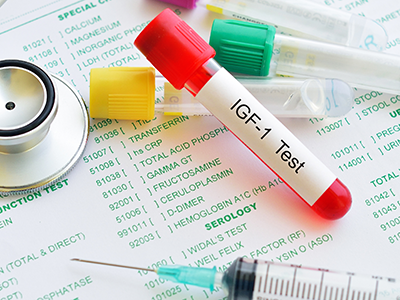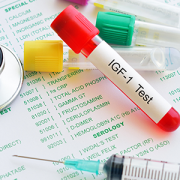
Andrew Dauber, M.D., MMSc., a pediatric endocrinologist and the chief of endocrinology at Children’s National, guided research presented at ENDO 2019, the Endocrine Society’s annual meeting, enabling clinicians and researchers to understand the genetic underpinnings of certain pediatric growth disorders, while using electronic health record (EHR) algorithms to screen for presenting symptoms in the exam room. In some cases, this prompts further genetic testing and shortens the diagnostic odyssey for pediatric growth disorders – such as Turner syndrome.
Here is a summary of the research findings, delivered as two oral abstracts and a poster session.
ABSTRACT 1: Presented on Saturday, March 23, at 12:30 p.m. CST
Healthy childhood growth cohort provides insight into PAPPA2 and IGF-1 relationship, revealing a new level of complexity to the biology of growth with implications for the study and treatment of severe growth disorders
Program: Growth, puberty, and insulin action and resistance
Session OR07-5: A Cross-Sectional Study of IGF-I Bioavailability through Childhood: Associations with PAPP-A2 and Anthropometric Data
Background: Insulin-like growth factor 1 (IGF-1) is a hormone essential for human growth and is often bound to IGFBP-3, an IGF binding protein. Pregnancy Associated Plasma Protein-A2 (PAPP-A2) cleaves intact IGFBP-3, freeing IGF-1 to support normal growth functions. This is the first study, led by Dr. Andrew Dauber with collaborators from Cincinnati Children’s Hospital Medical Center, to track PAPP-A2 and intact IGFBP-3 concentrations throughout childhood. The research team studied 838 healthy children, ages 3-18, in the Cincinnati Genomic Control Cohort, to better understand patterns of growth and development by examining the relationship between PAPPA2 and IGF-1 bioavailability.
Study results: Free IGF-1 increased with age. PAPP-A2, a positive modulator of IGF-1 bioavailability, decreased with age, which surprised the researchers, and is not positively associated with absolute levels of free IGF-1. However, higher levels of PAPP-A2 cleave IGFBP-3 resulting in lower levels of intact IGFBP-3, and consequently, increasing the percentage of free to total IGF-1. This demonstrates that PAPP-A2 is a key regulator of IGF-1 bioavailability on a population-wide scale.
Impact: This research may help endocrinologists create unique, targeted treatment for children with PAPPA2 mutations and could help stratify patients with potential risk factors, such as IGF-1 resistance due to increased binding of IGF-1, associated with severe growth and height disorders. See adjoining study below.
Watch: Video interview with Dr. Dauber
ABSTRACT 2: Presented on Saturday, March 23, at 12:45 p.m. CST
Electronic health records can alert physicians to patients who could benefit from genetic testing to identify severe growth disorders
Program: Growth, puberty, and insulin action and resistance
Session OR07-6: Integrating Targeted Bioinformatic Searches of the Electronic Health Records and Genomic Testing Identifies a Molecular Diagnosis in Three Patients with Undiagnosed Short Stature
Background: Despite referrals to pediatric endocrinologists and extensive hormonal analysis, children with short stature due to a genetic cause, may not receive a diagnosis. Electronic health records may help identify patients – based on associated phenotypes and clinical parameters – who could benefit from genetic testing.
Study results: Researchers from three children’s hospitals – Boston Children’s Hospital, Children’s Hospital of Philadelphia and Cincinnati Children’s Hospital Medical Center – gathered data, starting small, with a known variable, or phenotype, associated with severe growth disorders: insulin-like growth factor 1 (IGF-1) resistance. A targeted bioinformatics search of electronic health records led the team to identify 39 eligible patients out of 234 candidates who met the criteria for a possible genetic-linked growth disorder. Participants were included if their height fell below two standard deviations for age and sex and if their IGF-1 levels rose above the 90th percentile. Patients who had a chronic illness, an underlying genetic condition or precocious puberty were excluded. Whole-exome sequencing (WES) was performed on DNA extracted from willing participants, including 10 patients and their immediate family members. The research team identified new genetic causes in three out of 10 patients with severe growth disorders, who were previously missed as having a genetic-linked growth disorder.
Note: Two patients had two novel IGF1R gene variants; a third had a novel CHD2 variant (p. Val540Phe). The two patients with IGF1R variants had a maternally inherited single amino acid deletion (p.Thr28del) and a novel missense variant (p. Val1013Phe).
Impact: Similar EHR algorithms can be replicated to identify pediatric patients at risk for or thought to have other genetic disorders, while expanding genetic research and improving patient care.
Watch: Video interview with Dr. Dauber
POSTER: Presented on Monday, March 25, at 1 p.m. CST
Electronic health record alerts could help detect Turner syndrome, shorten diagnostic odyssey for girls born with a missing or partially-deleted X chromosome
Program: Session P54. Pediatric puberty, ovarian function, transgender medicine and obesity
Poster Board #MON-249: Algorithm-Driven Electronic Health Record Notification Enhances the Detection of Turner Syndrome
Background: Turner syndrome (TS) results from a complete or partial loss of the second X chromosome and affects about one in every 2,500 female births. TS is common in females with unexplained short stature, but the diagnosis is often not made until late childhood (8-9 years), leading to delays in treatment and screening for comorbidities, such as heart conditions, chronic ear infections, vision problems and challenges with non-verbal learning. Using electronic health record (EHR) alarms can help clinicians screen for and diagnose TS patients earlier in life.
Study results: Researchers from Cincinnati Children’s Hospital Medical Center searched EHRs for female patients with idiopathic short stature who met the team’s selection criteria: Their height fell below two standard deviations from the mean for age as well as one standard deviation below the mid-parental height, had a BMI greater than 5 percent and did not have a chronic illness. The search produced 189 patients who met the diagnostic criteria, 72 of whom had not received prior genetic testing. Out of genetic samples available, 37 were compatible for a microarray analysis – which helped the team identify two cases of TS and a third chromosomal abnormality, all of which were missed by routine clinical evaluation.
Impact: DNA samples may not be available for all patients, but clinicians and researchers can identify and integrate tools into EHR’s – creating their own algorithms. An example includes setting up alerts for specific growth parameters, which helps identify and screen patients for TS.
The abstracts Dr. Dauber and his team discuss at ENDO 2019 support ongoing research, including a partnership among four leading children’s hospitals – Children’s National Health System, Boston Children’s Hospital, Children’s Hospital of Philadelphia and Cincinnati Children’s Medical Center – funded by an R01 grant to study how electronic health records can detect and identify novel markers of severe growth disorders.
The researchers hope their findings will also identify and help screen for comorbidities associated with atypical growth patterns, supporting multidisciplinary treatment throughout a child’s life. The study started in August 2018 and includes three sets of unique diagnostic criteria and will analyze WES from dozens of patients over five years.
Read more about Dr. Dauber’s research presented at ENDO 2019 in Endocrine Today and watch his video commentary with Medscape.







